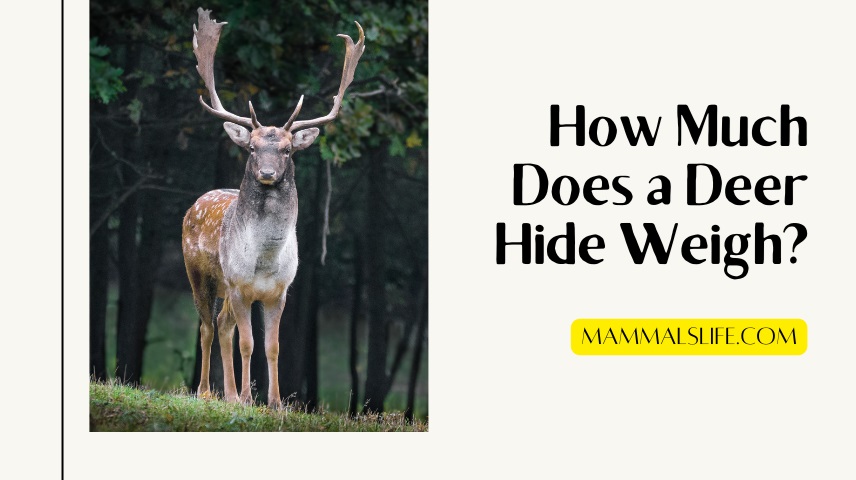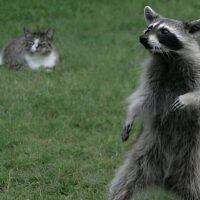Last Updated on February 22, 2025 by Mammals Life
Deer cannot see red light. Their vision is limited to blue and green wavelengths.
Deer have unique vision adapted for their survival. Understanding their light sensitivity helps hunters and wildlife enthusiasts. Deer primarily see in the blue and green spectrum, making red light invisible to them. This trait allows the use of red lights for observation without disturbing them.
Knowing how deer perceive light can improve outdoor activities and ensure minimal disruption to their natural behavior. Deer vision research also aids in developing better safety measures for drivers in deer-populated areas. By comprehending deer vision, we can coexist more harmoniously with these fascinating creatures.
Deer Vision Basics
Understanding how deer see the world helps hunters and wildlife enthusiasts. Deer vision is different from human vision. This section explores the basics of deer vision.
Anatomy Of Deer Eyes
Deer eyes are large and set on the sides of their heads. This placement gives them a wide field of view. They can see almost 310 degrees around them. This helps them detect predators quickly.
Deer have more rods than cones in their retinas. Rods help them see in low light. This makes deer good at seeing in the dark. Cones help with color vision, but deer have fewer cones.
Color Perception In Deer
Deer are dichromatic, meaning they see two primary colors. Humans are trichromatic and see three primary colors. Deer see shades of blue and green well. Red appears as shades of gray or brown to them.
Understanding deer color perception helps in choosing hunting gear. Wearing red or orange makes you less visible to deer. They cannot see these colors well.
| Feature | Deer | Humans |
|---|---|---|
| Field of View | 310 degrees | 180 degrees |
| Number of Rods | More | Fewer |
| Number of Cones | Fewer | More |
| Color Vision | Dichromatic | Trichromatic |
Light Sensitivity In Deer
Deer have unique vision abilities. Their light sensitivity is fascinating. Understanding this can help in wildlife management and hunting. This section explores deer vision and light sensitivity.
Night Vision Capabilities
Deer can see well in the dark. They have more rod cells than humans. Rod cells help them see in low light. Deer eyes reflect light, which makes their eyes glow in the dark. This enhances their night vision. They can detect movement even in very dim light.
Deer are mostly active at dawn and dusk. Their eyes are adapted to these low-light times. This helps them avoid predators. They can see better at night than during the day.
Daylight Adaptations
During the day, deer rely on their cone cells. These cells help them see colors. Deer have fewer cone cells than humans. They can see blue and green but not red. This means red light appears dark to them. This is why red clothing can be effective in hunting.
Deer have a wide field of view. They can see almost 310 degrees around them. This helps them detect predators easily. Their eyes are on the sides of their head. This placement gives them a panoramic view.
| Feature | Deer Vision |
|---|---|
| Night Vision | Excellent |
| Day Vision | Moderate |
| Color Detection | Blue and Green |
| Field of View | 310 degrees |
Understanding deer light sensitivity can help in various activities. Whether you are a hunter or a wildlife enthusiast, knowing about deer vision is beneficial.
Red Light Visibility
Can deer see the red light? This question often intrigues hunters and wildlife enthusiasts. Deer vision and light sensitivity are unique compared to humans. Understanding their ability to see red light can improve hunting strategies and wildlife observation.
Color Spectrum Analysis
Deer vision does not cover the full human color spectrum. Humans see a broad range of colors due to three types of cones in their eyes. Deer have only two types of cones. This limits their color perception. Let’s break down the color spectrum analysis:
- Humans: See red, green, and blue.
- Deer: See blue and green, but not red.
This means deer are red-green colorblind. They see red as shades of gray or brown. This makes red light less visible to them.
Scientific Studies
Several scientific studies have explored deer vision and light sensitivity. These studies provide insights into their ability to see red light.
| Study | Findings |
|---|---|
| Johns Hopkins University | Deer lack red cone cells. |
| University of Georgia | Deer are more sensitive to blue and UV light. |
These studies confirm that deer have poor red-light visibility. This can be useful for nighttime activities. Using a red light can avoid alerting deer. It helps in approaching deer without being noticed.
Comparing Deer Vision To Humans
Deer and humans see the world differently. Deer vision varies from human vision. This difference impacts how they perceive their environment.
Key Differences
Deer eyes are on the sides of their heads. This gives them a wide field of view. Humans have forward-facing eyes. This gives us depth perception and binocular vision.
Color vision is another key difference. Deer are dichromatic. They see two primary colors: blue and green. Humans are trichromatic. We see red, green, and blue.
Deer have more rod cells in their eyes. Rod cells help them see in low light. Humans have more cone cells. Cone cells help us see colors and details.
| Feature | Deer | Humans |
|---|---|---|
| Eye Placement | Sides | Front |
| Color Vision | Dichromatic (Blue, Green) | Trichromatic (Red, Green, Blue) |
| Rod Cells | More | Fewer |
| Cone Cells | Fewer | More |
Implications For Hunters
Understanding deer vision helps hunters. Deer see blue and green well. They do not see red as clearly. Wearing red or orange can help hunters stay hidden.
Deer can see well in low light. This means hunting at dawn or dusk can be challenging. Use this knowledge to plan hunting trips. Choose clothing and gear wisely.
Deer have a wide field of view. They can detect movement easily. Staying still is crucial. Move slowly and quietly. Use their vision limitations to your advantage.
- Wear red or orange to blend in.
- Hunt during daylight for better chances.
- Stay still and move quietly.
Practical Applications
Understanding deer vision can help hunters and wildlife enthusiasts. Using red lights can offer practical benefits in the field. This section explores how red lights affect deer behavior and their potential uses.
Using Red Lights In The Field
Red lights are less likely to startle deer. Hunters use red lights to navigate without disturbing deer. Wildlife photographers also use red lights to capture nocturnal scenes.
| Application | Benefit |
|---|---|
| Hunting | Move silently without alerting deer |
| Photography | Capture natural behavior at night |
| Wildlife Observation | Observe nocturnal activities |
Impact On Deer Behavior
Deer are less sensitive to red light. They perceive it as a dull glow. This makes it easier to approach them without causing alarm. Red lights help hunters to stay hidden. They also help in setting up gear without scaring deer away.
- Deer remains calm under red light.
- Red light helps in silent movement.
- Perfect for setting up equipment discreetly.
Using red lights can minimize human impact on deer habitats. It ensures deer behavior remains natural. This makes for a better and more ethical wildlife experience.
Future Research
The question of whether deer can see red light has intrigued scientists for years. Future research aims to uncover more about deer vision and their light sensitivity. This research will help us understand how deer perceive the world around them.
Technological Advances
New technology is helping scientists study deer vision. Advanced imaging techniques allow researchers to see how deer eyes work. Special cameras can capture what deer might see. These cameras simulate how light affects deer vision.
Another technological advance is the use of artificial intelligence. AI can analyze large sets of data quickly. This helps scientists make sense of complex information about deer vision. AI can also predict how changes in light affect deer behavior.
Wearable devices for deer are also being developed. These devices track deer movements and reactions to different lights. This data provides real-world insights into deer vision and sensitivity.
Potential Discoveries
Future research may lead to exciting discoveries. Scientists hope to find out if deer see colors we can’t see. This could change our understanding of the animal world.
Researchers are also exploring the impact of light pollution on deer. Light pollution might affect how deer navigate and find food. Understanding this can help in creating better wildlife conservation strategies.
Another potential discovery is how deer vision changes with age. Older deer might see differently than younger ones. This information can help in managing deer populations more effectively.
Future studies might reveal how deer vision compares to other animals. This can provide a broader view of how different species perceive light.
| Research Focus | Potential Impact |
|---|---|
| Impact of Light Pollution | Better conservation strategies |
| Age-related Vision Changes | Improved population management |
| Comparison with Other Species | Broader understanding of animal vision |
Frequently Asked Questions
Can A Deer See Red Light?
Deer cannot see red light well. They have dichromatic vision, meaning they see blues and greens better. Red appears as a shade of gray.
What Color Light Can Deer See?
Deer can see colors in the blue and green spectrum. They struggle to see reds and oranges. This helps them detect movement and stay alert in their environment.
What Color Flashlight Is Best For Deer Hunting?
The best color flashlight for deer hunting is red or green. These colors are less likely to spook deer.
Can Deer See Red Laser?
Deer struggle to see red lasers. Their vision is more sensitive to blue and green wavelengths. Red appears as a muted gray.
Can Deer See Red Light?
No, deer cannot see red light. They are more sensitive to blue and green wavelengths.
What Colors Can Deer See?
Deer can see shades of blue and green. They have dichromatic vision, meaning they see fewer colors than humans.
Conclusion
Understanding deer vision and light sensitivity can enhance wildlife management and hunting strategies. Deer struggle to see red light, making it useful for nighttime activities. By leveraging this knowledge, you can better coexist with these fascinating creatures. Enhance your experience in nature with informed decisions.











